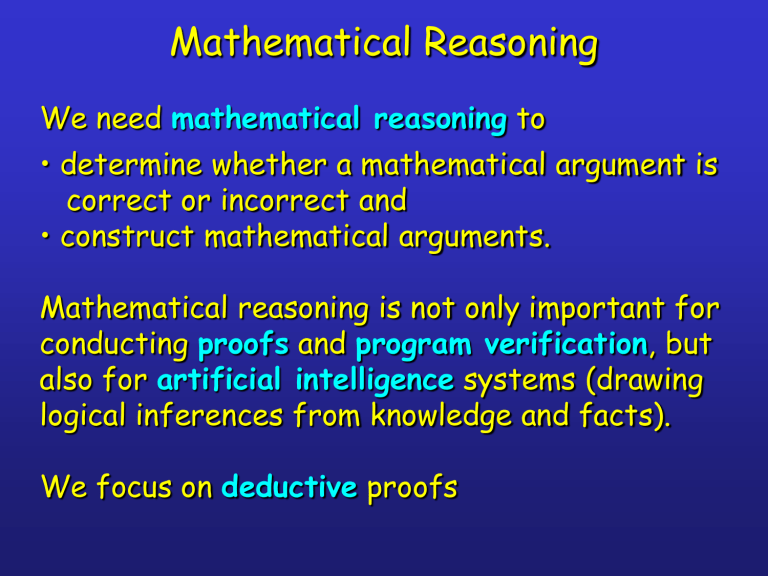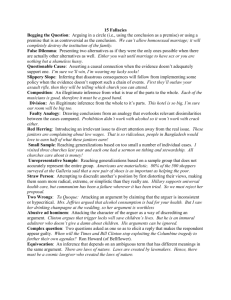
Mathematical Reasoning We need mathematical reasoning to • determine whether a mathematical argument is correct or incorrect and • construct mathematical arguments. Mathematical reasoning is not only important for conducting proofs and program verification, but also for artificial intelligence systems (drawing logical inferences from knowledge and facts). We focus on deductive proofs Terminology An axiom is a basic assumption about mathematical structure that needs no proof. - Things known to be true (facts or proven theorems) - Things believed to be true but cannot be proved We can use a proof to demonstrate that a particular statement is true. A proof consists of a sequence of statements that form an argument. The steps that connect the statements in such a sequence are the rules of inference. Cases of incorrect reasoning are called fallacies. Terminology A theorem is a statement that can be shown to be true. A lemma is a simple theorem used as an intermediate result in the proof of another theorem. A corollary is a proposition that follows directly from a theorem that has been proved. A conjecture is a statement whose truth value is unknown. Once it is proven, it becomes a theorem. Proofs A theorem often has two parts - Conditions (premises, hypotheses) - conclusion A correct (deductive) proof is to establish that - If the conditions are true then the conclusion is true - I.e., Conditions conclusion is a tautology Often there are missing pieces between conditions and conclusion. Fill it by an argument - Using conditions and axioms - Statements in the argument connected by proper rules of inference Rules of Inference Rules of inference provide the justification of the steps used in a proof. One important rule is called modus ponens or the law of detachment. It is based on the tautology (p (p q)) q. We write it in the following way: The two hypotheses p and p q are p written in a column, and the conclusion p q below a bar, where means “therefore”. ____ q Rules of Inference The general form of a rule of inference is: p1 p2 . . . pn ____ q The rule states that if p1 and p2 and … and pn are all true, then q is true as well. Each rule is an established tautology of p1 p2 … p n q These rules of inference can be used in any mathematical argument and do not require any proof. Rules of Inference p _____ Addition pq q p q Modus _____ tollens p pq _____ Simplification p pq Hypothetical qr _____ syllogism p r (chaining) p q _____ Conjunction pq pq Disjunctive p _____ syllogism (resolution) q 7 Arguments Just like a rule of inference, an argument consists of one or more hypotheses (or premises) and a conclusion. We say that an argument is valid, if whenever all its hypotheses are true, its conclusion is also true. However, if any hypothesis is false, even a valid argument can lead to an incorrect conclusion. Proof: show that hypotheses conclusion is true using rules of inference 8 Arguments Example: “If 101 is divisible by 3, then 1012 is divisible by 9. 101 is divisible by 3. Consequently, 1012 is divisible by 9.” Although the argument is valid, its conclusion is incorrect, because one of the hypotheses is false (“101 is divisible by 3.”). If in the above argument we replace 101 with 102, we could correctly conclude that 1022 is divisible by 9. Arguments Which rule of inference was used in the last argument? p: “101 is divisible by 3.” q: “1012 is divisible by 9.” p p q Modus _____ ponens q Unfortunately, one of the hypotheses (p) is false. Therefore, the conclusion q is incorrect. Arguments Another example: “If it rains today, then we will not have a barbeque today. If we do not have a barbeque today, then we will have a barbeque tomorrow. Therefore, if it rains today, then we will have a barbeque tomorrow.” This is a valid argument: If its hypotheses are true, then its conclusion is also true. Arguments Let us formalize the previous argument: p: “It is raining today.” q: “We will not have a barbecue today.” r: “We will have a barbecue tomorrow.” So the argument is of the following form: pq Hypothetical qr ______ syllogism Pr Arguments Another example: Gary is either intelligent or a good actor. If Gary is intelligent, then he can count from 1 to 10. Gary can only count from 1 to 3. Therefore, Gary is a good actor. i: “Gary is intelligent.” a: “Gary is a good actor.” c: “Gary can count from 1 to 10.” Arguments i: “Gary is intelligent.” a: “Gary is a good actor.” c: “Gary can count from 1 to 10.” Step 1: Step 2: Step 3: Step 4: Step 5: c i c i ai a Hypothesis Hypothesis Modus tollens Steps 1 & 2 Hypothesis Disjunctive Syllogism Steps 3 & 4 Conclusion: a (“Gary is a good actor.”) Arguments Yet another example: If you listen to me, you will pass CS 320. You passed CS 320. Therefore, you have listened to me. Is this argument valid? No, it assumes ((p q) q) p. This statement is not a tautology. It is false if p is false and q is true. Rules of Inference for Quantified Statements x P(x) __________ P(c) if cU Universal instantiation P(c) for an arbitrary cU ___________________ x P(x) Universal generalization x P(x) ______________________ P(c) for some element cU Existential instantiation P(c) for some element cU ____________________ x P(x) Existential generalization Rules of Inference for Quantified Statements Example: Every UMB student is a genius. George is a UMB student. Therefore, George is a genius. U(x): “x is a UMB student.” G(x): “x is a genius.” Rules of Inference for Quantified Statements The following steps are used in the argument: Step 1: x (U(x) G(x)) Hypothesis Step 2: U(George) G(George) Univ. instantiation using Step 1 Step 3: U(George) Hypothesis Step 4: G(George) Modus ponens using Steps 2 & 3 x P(x) __________ P(c) if cU Universal instantiation Proving Theorems Direct proof: An implication p q can be proved by showing that if p is true, then q is also true. Example: Give a direct proof of the theorem “If n is odd, then n2 is odd.” Idea: Assume that the hypothesis of this implication is true (n is odd). Then use rules of inference and known theorems of math to show that q must also be true (n2 is odd). Proving Theorems n is odd. Then n = 2k + 1, where k is an integer. Consequently, n2 = (2k + 1)2. = 4k2 + 4k + 1 = 2(2k2 + 2k) + 1 Since n2 can be written in this form, it is odd. Proving Theorems Indirect proof: An implication p q is equivalent to its contrapositive q p. Therefore, we can prove p q by showing that whenever q is false, then p is also false. Example: Give an indirect proof of the theorem “If 3n + 2 is odd, then n is odd.” Idea: Assume that the conclusion of this implication is false (n is even). Then use rules of inference and known theorems to show that p must also be false (3n + 2 is even). Proving Theorems n is even. Then n = 2k, where k is an integer. It follows that 3n + 2 = 3(2k) + 2 = 6k + 2 = 2(3k + 1) Therefore, 3n + 2 is even. We have shown that the contrapositive of the implication is true, so the implication itself is also true (If 3n + 2 is odd, then n is odd). Proving Theorems Indirect Proof is a special case of proof by contradiction Suppose n is even (negation of the conclusion). Then n = 2k, where k is an integer. It follows that 3n + 2 = 3(2k) + 2 = 6k + 2 = 2(3k + 1) Therefore, 3n + 2 is even. However, this is a contradiction since 3n + 2 is given to be odd, so the conclusion (n is odd) holds. Another Example on Proof Anyone performs well is either intelligent or a good actor. If someone is intelligent, then he/she can count from 1 to 10. Gary performs well. Gary can only count from 1 to 3. Therefore, not everyone is both intelligent and a good actor P(x): x performs well I(x): x is intelligent A(x): x is a good actor C(x): x can count from 1 to 10 Another Example on Proof Hypotheses: 1. Anyone performs well is either intelligent or a good actor. x (P(x) I(x) A(x)) 2. If someone is intelligent, then he/she can count from 1 to 10. x (I(x) C(x) ) 3. Gary performs well. P(G) 4. Gary can only count from 1 to 3. C(G) Conclusion: not everyone is both intelligent and a good actor x(I(x) A(x)) Another Example on Proof Direct proof: Step 1: x (P(x) I(x) A(x)) Step 2: P(G) I(G) A(G) Step 3: P(G) Step 4: I(G) A(G) Step 5: x (I(x) C(x)) Step 6: I(G) C(G) Step 7: C(G) Step 8: I(G) Step 9: I(G) A(G) Step 10: (I(G) A(G)) Step 11: x(I(x) A(x)) Step 12: x (I(x) A(x)) Hypothesis Univ. Inst. Step 1 Hypothesis Modus ponens Steps 2 & 3 Hypothesis Univ. inst. Step5 Hypothesis Modus tollens Steps 6 & 7 Addition Step 8 Equivalence Step 9 Exist. general. Step 10 Equivalence Step 11 Conclusion: x (I(x) A(x)), not everyone is both intelligent and a good actor. Summary, Section 1.5 • Terminology (axiom, theorem, conjecture, argument, etc.) • Rules of inference (Tables 1 and 2) • Valid argument (hypotheses and conclusion) • Construction of valid argument using rules of inference – For each rule used, write down and the statements involved in the proof • Direct and indirect proofs – Other proof methods (e.g., induction, pigeon hole) will be introduced in later chapters





